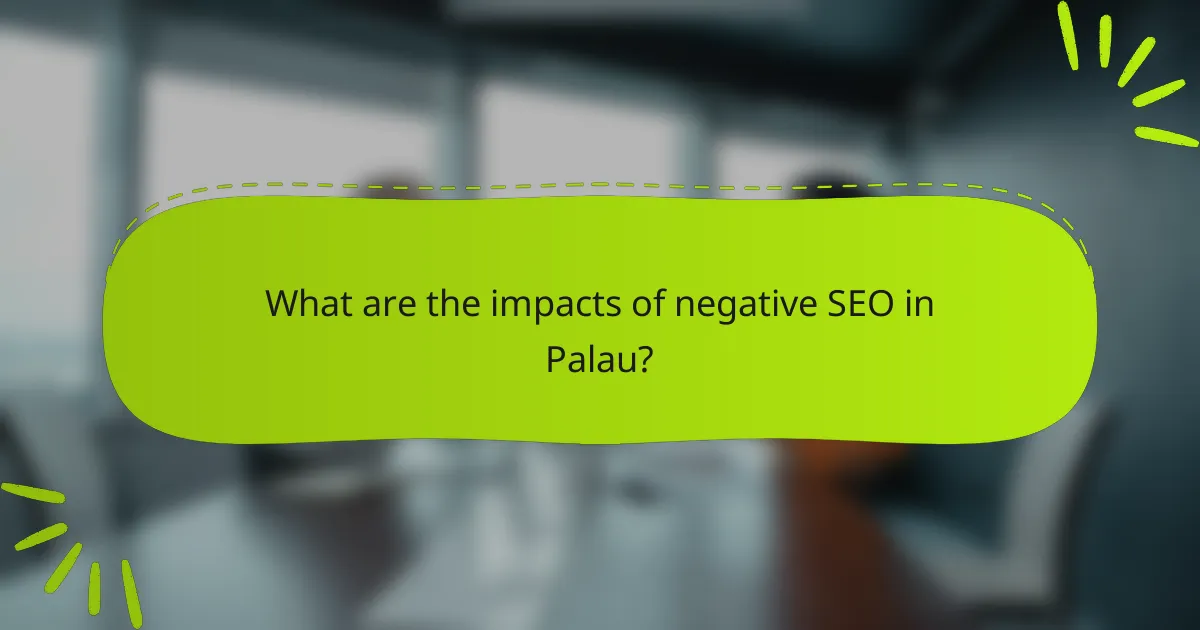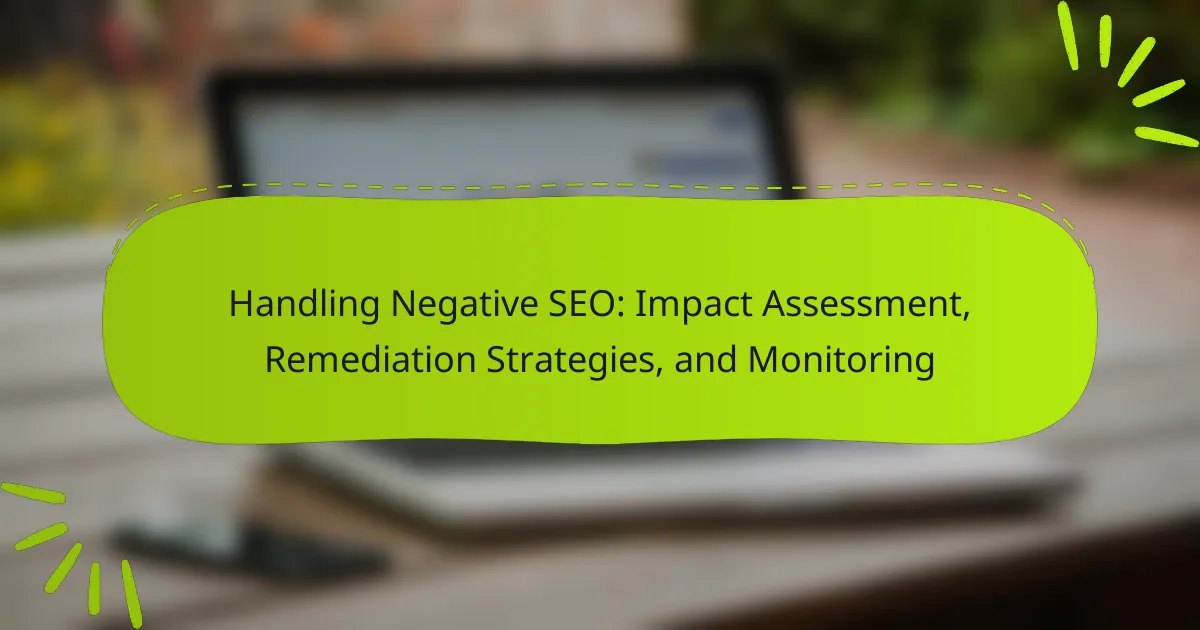Negative SEO poses a serious threat to websites, particularly in terms of traffic reduction, diminished search engine rankings, and potential damage to brand reputation. It is essential for businesses to assess the impact of such attacks by monitoring performance and backlink profiles. Implementing effective remediation strategies, such as disavowing harmful links and enhancing site security, can help restore and protect a website’s online presence.

What are the impacts of negative SEO in Palau?
Negative SEO can significantly harm websites in Palau by reducing traffic, lowering search engine rankings, and damaging brand reputation. Understanding these impacts is crucial for businesses to protect their online presence and mitigate potential losses.
Traffic decline
Negative SEO often leads to a noticeable decline in website traffic. This can occur due to tactics such as spammy backlinks or content scraping, which can confuse search engines and lead to penalties. Businesses may experience drops in visitor numbers ranging from low tens to over fifty percent, affecting revenue and engagement.
To combat traffic decline, regularly monitor website analytics for unusual patterns. Identifying sudden drops can help in taking timely actions, such as disavowing harmful links or improving site security.
Loss of rankings
One of the most direct impacts of negative SEO is the loss of search engine rankings. When a site is targeted with malicious tactics, it may be pushed down in search results, making it harder for potential customers to find. This can lead to long-term visibility issues, especially if recovery actions are not taken promptly.
To minimize ranking loss, maintain a strong backlink profile and regularly audit for toxic links. Tools like Google Search Console can help identify harmful backlinks that need to be disavowed.
Brand reputation damage
Negative SEO can severely damage a brand’s reputation, as it may lead to negative reviews or misinformation being spread online. This can create a perception of untrustworthiness among potential customers, which is difficult to reverse. The impact on brand loyalty can be significant, particularly in a small market like Palau.
To protect brand reputation, engage actively with customers on social media and review platforms. Addressing concerns quickly and transparently can help mitigate the effects of negative SEO and rebuild trust.

How to assess negative SEO attacks?
Assessing negative SEO attacks involves identifying unusual patterns in your website’s performance and backlink profile. By closely monitoring these elements, you can determine if malicious actions are impacting your site’s rankings and visibility.
Using Google Search Console
Google Search Console (GSC) is a vital tool for assessing negative SEO attacks. It provides insights into your website’s search performance, including any sudden drops in rankings or visibility. Regularly check the “Security & Manual Actions” section to identify any notifications regarding spammy backlinks or manual penalties.
Utilize the “Performance” report to track fluctuations in clicks and impressions. A significant decline may indicate negative SEO efforts, prompting further investigation into your backlink profile and site health.
Analyzing backlink profiles
Analyzing your backlink profile is crucial for detecting negative SEO. Use tools like Ahrefs or Moz to review your incoming links regularly. Look for sudden spikes in low-quality or spammy backlinks, which can harm your site’s authority and rankings.
Consider disavowing harmful links through Google’s Disavow Tool if you identify malicious backlinks. This action can help protect your site from penalties associated with negative SEO tactics.
Monitoring site performance metrics
Monitoring site performance metrics is essential for assessing the impact of negative SEO. Track key performance indicators (KPIs) such as organic traffic, bounce rates, and conversion rates. A sudden drop in these metrics may signal an ongoing negative SEO attack.
Set up alerts for significant changes in performance metrics to respond quickly. Tools like Google Analytics can help you visualize trends and identify anomalies that may require further investigation or remediation strategies.

What remediation strategies can be implemented?
To effectively combat negative SEO, several remediation strategies can be employed. These strategies focus on disavowing harmful backlinks, improving content quality, and enhancing site security to restore and protect your website’s reputation.
Disavowing harmful backlinks
Disavowing harmful backlinks involves identifying and rejecting links from low-quality or spammy websites that could negatively impact your site’s authority. Use tools like Google Search Console to find these links and create a disavow file to submit to Google.
Regularly review your backlink profile, as new harmful links can appear over time. Aim to disavow links that are clearly irrelevant or from domains with a poor reputation, as this can help improve your site’s standing in search results.
Improving content quality
Enhancing content quality is crucial for mitigating the effects of negative SEO. Focus on creating original, informative, and engaging content that meets the needs of your audience. This can help improve user engagement and reduce bounce rates.
Regularly update existing content to ensure it remains relevant and accurate. Consider conducting keyword research to optimize your content for search engines while maintaining a natural flow that appeals to readers.
Enhancing site security
Improving site security is vital to protect against malicious attacks that can lead to negative SEO. Implement HTTPS to secure data transmission and regularly update your website’s software and plugins to patch vulnerabilities.
Consider using security tools that monitor for suspicious activity and provide alerts for potential threats. Regular backups of your website can also help you recover quickly in case of an attack, minimizing downtime and potential damage to your SEO efforts.

How to monitor for negative SEO threats?
Monitoring for negative SEO threats involves regularly checking your website’s performance and backlink profile to identify any unusual patterns that could indicate malicious activity. By staying vigilant, you can quickly address potential issues before they significantly impact your site’s rankings.
Regular backlink audits
Conducting regular backlink audits is crucial for detecting negative SEO. Use tools like Ahrefs or SEMrush to analyze your backlink profile and identify any suspicious links that may harm your site’s reputation. Aim to perform these audits monthly or quarterly, depending on your site’s size and activity level.
When auditing, look for links from low-quality or irrelevant sites, as these can signal negative SEO attacks. If you find harmful links, consider disavowing them through Google’s Disavow Tool to protect your site’s authority.
Setting up alerts for unusual traffic
Setting up alerts for unusual traffic patterns can help you catch negative SEO threats early. Use Google Analytics to create custom alerts that notify you of significant drops in traffic or spikes in referral traffic from unknown sources.
For instance, if you notice a sudden increase in traffic from a specific country or website that doesn’t align with your target audience, investigate further. This could indicate a negative SEO attack or other issues that need immediate attention.
Using SEO monitoring tools
Utilizing SEO monitoring tools can streamline the process of tracking potential negative SEO threats. Tools like Moz, SEMrush, or Google Search Console can provide insights into your site’s health, keyword rankings, and backlink profile.
These tools often include features that alert you to significant changes in rankings or backlinks, allowing you to respond quickly. Regularly review the data provided by these tools to stay informed about your site’s performance and any potential threats.

What are the prerequisites for effective negative SEO management?
Effective negative SEO management requires a proactive approach that includes monitoring your website’s performance and implementing security measures. Understanding the potential threats and having a solid strategy in place can help mitigate risks and protect your online presence.
Establishing baseline metrics
Establishing baseline metrics is crucial for identifying any unusual changes in your website’s performance. Start by tracking key performance indicators (KPIs) such as organic traffic, keyword rankings, and backlink profiles. Regularly monitoring these metrics allows you to detect sudden drops that may indicate negative SEO attacks.
Utilize tools like Google Analytics and Search Console to gather data on your site’s performance. Set up alerts for significant fluctuations in traffic or rankings, which can help you respond quickly to potential threats. Aim to review these metrics at least monthly to maintain an accurate picture of your site’s health.
Implementing robust security measures
Implementing robust security measures is essential to protect your website from negative SEO tactics. Start by ensuring your site has an SSL certificate, which secures data transfer and builds trust with users and search engines. Regularly update your CMS and plugins to patch vulnerabilities that attackers might exploit.
Consider employing a web application firewall (WAF) to filter out malicious traffic and prevent unauthorized access. Additionally, monitor your backlink profile for spammy links and disavow them through Google Search Console to maintain your site’s authority. Regular security audits can help identify and address potential weaknesses before they are exploited.

How does negative SEO differ from other SEO issues?
Negative SEO involves malicious tactics aimed at harming a competitor’s search engine rankings, unlike typical SEO challenges that arise from algorithm changes or content quality. Understanding this distinction is crucial for identifying and addressing negative SEO effectively.
Intentional sabotage vs. algorithm changes
Intentional sabotage refers to deliberate actions taken by competitors to undermine your website’s performance, such as building spammy backlinks or creating duplicate content. These tactics are designed to manipulate search engine algorithms against your site, often resulting in penalties or decreased visibility.
In contrast, algorithm changes are updates made by search engines to improve the quality of search results. These updates can affect rankings based on factors like content relevance and user experience, but they are not targeted actions against a specific site. For example, a site may drop in rankings due to a Google update that prioritizes mobile-friendly designs, rather than an attack from a rival.
To mitigate the impact of both intentional sabotage and algorithm changes, regularly monitor your site’s backlinks and performance metrics. Use tools like Google Search Console to identify unusual spikes in negative activity or drops in rankings, allowing for timely remediation.
